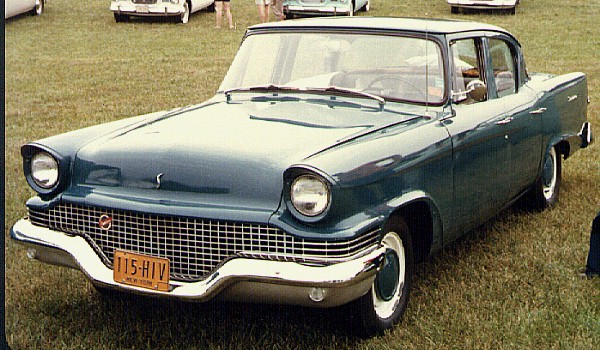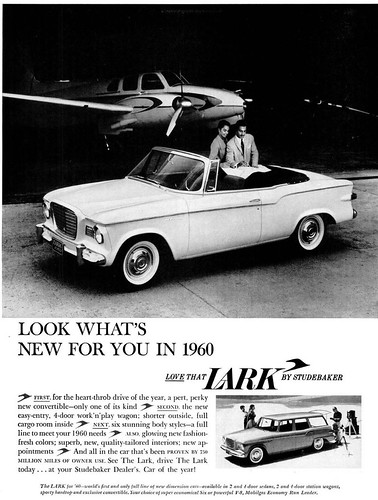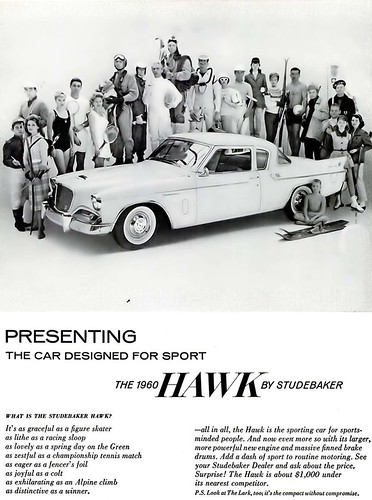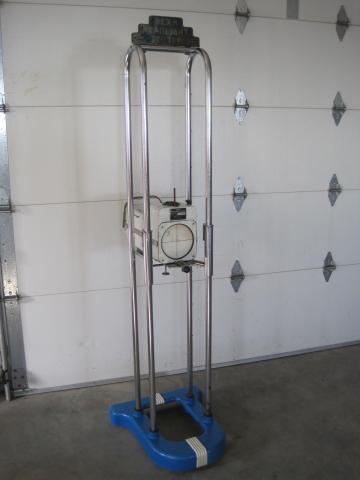A persistent small drip from Barney's rear end finally led me to get under the car and inspect the cause. It turned out to be the fact that most of the differential cover bolts had vibrated loose. Obviously, they needed tightening.
As Barney's 1,000-mile chassis lube was coming up (Studes need chassis lubrication every 1k - not like today's 10,000-mile wonders!), I decided I'd do both on the same day, and picked out a nice Saturday to get 'er done.

The first task was to get his butt up in the air. As there are no front parking brakes, it's necessary to lift both front and rear in order to be safe. Note that there are chocks on both sides of the rear tires, as well as jack stands at the rear and front chassis fishplates. You can't be too safe, no matter what car you're working on! Use proper jack stands in good condition and make sure that, when you're rolling around under there, you don't use the chassis as leverage to move - it doesn't take much to pull the car off the stands and down onto you. This generally goes poorly for the human component.
The reason you want to lift the rear end for this is that you're going to need some elbow room. When the car's suspension is fully compressed, the upper differential cover bolts are difficult to access, since they're hidden behind the forward edge of the fuel tank. With the rear end fully lifted, you can easily get to all the cover bolts.
Getting out the trusty Studebaker Shop Manual, I found that there is a torque spec listed for the cover bolts (as there is on nearly everything!). Barney's axle is a Dana 44 limited-slip differential (known to Stude lovers as a Twin-Traction axle - PosiTraction if you're a Chevy fan), so the torque spec is listed as 25 - 30 foot-pounds. Don't use this spec if you have a Dana 27 rear end; the torque required is much lower.
In fact, I learned something important: you may not want to use
any torque spec for this operation. But more on that later.
Anyway, I got out my big 1/2"-drive Craftsman DigiTork and proceeded to tighten up the cover bolts. And they were
loose. Some at the top were very nearly finger-tight. No wonder it was dripping! So, working my way around, I tightened up each bolt. And, of course, on the
very last bolt, something went wrong. The bolt wouldn't torque up, and...well, you know what happened next.
Yep. Off twisted the bolt-head and into the pan it dropped. And the leak, which had previously declined as the cover was tightened, suddenly turned into a significant dribble.
As the sweat started forming on my forehead, I remembered that I had a set of quality bolt extractors. I was going to have to drill out that booger.
This is a tool everyone should have in their box, because sooner or later, you
will bust off a bolt. These are reverse-extractors: first the chisel-tip drills the center out of the broken fastener, and then the threaded collar bites into the drill-hole and backs the fastener out of its place.
By the way, be safe: wear goggles when you do this work. Flying steel chips and eyeballs are not a great combination, ya dig?
So I went to work, beginning to drill out the broken bolt, when - wonder of wonders! - something awesome happened. The bolt head had broken off in such a way that it left a nearly straight ridge of metal left across the face of the shaft. When I began to drill, the extractor caught that ridge and the broken shaft backed out of the axle housing like a hot knife goes through butter - no drilling needed. Thank you, God!
As you can see from the pic above, the bolt stretched. You can actually see the deformation of the threads. This failure mode is really what saved my bacon. As Bob Palma (the SDC Technical Editor) noted in
this thread on the Studebaker Drivers Club Forum, had it bottomed and been impacted, removal would have been a ton tougher.
Here's where the learning comes in. Even though there's a torque spec in the shop manual, Bob recommends not using it. An automotive professional for over 40 years, Bob says:
I don't even torque mine; I just use a step-down reducer from 3/8 to
1/4 inch drive and then tighten them about as tight as I can get them with a 1/4" drive ratchet, which, as you know, is pretty small. That doesn't squeeze out the gasket, as do higher torques.
And that's just what I'll do next time.
I had a new bolt of the proper size in my bin, so I screwed it in and the leak stopped, but now I'd need to refill the axle. Running a differential dry isn't good for you, for your car, or for your wallet! So down went the car, under went the catch basin, and out came the gear lube. Why lower the car, when having it up would have made filling easier? Because you fill the axle with lube even with the bottom of the fill hole, so the car must be level when you do it.
Removing the filler plug will require a Crescent wrench; a 12" should do.
Just so happens I was prepared, with a brand-new bottle of gear lube in the garage. Now, some guys stick a clear vinyl tube on the bottle spout and stick it in the hole to fill the axle; others have used their wives' turkey baster (not a recommended procedure!). I prefer to add a little at a time, so as not to overfill and have a river of lube pouring into the pan. I used a spare medical syringe available at any pharmacy.
As it turns out, the axle was pretty empty. It took about 20 of these - I estimate between 1.5 and 2 cups of gear lube went in before the proper level was reached.
See the differential gear carrier, visible inside the case through the hole? Besides the tags on the axle housing, this is one way to physically confirm that the axle is a real Twin-Traction limited-slip diff - the carrier is so large that an index finger inserted in the hole will be stopped by the carrier at the first knuckle. If the differential was a standard "open" unit, you'd be able to get an entire finger in there.
In this photo, you can see a little trickle of lube out of the hole. That means it's filled to the proper level. After it's filled, all that remains is to wipe the case and reinstall the filler plug. Remember, you're going into a steel cover with a cast-iron plug - so clean the threads and tighten it up snug, but not so tight that you strip it out.
All back together - and just in time for International Drive Your Studebaker Day on September 14th! All's well that ends well. And all's well that doesn't leak, too.
Labels: differential, My Lark, rear axle, Repair






















































